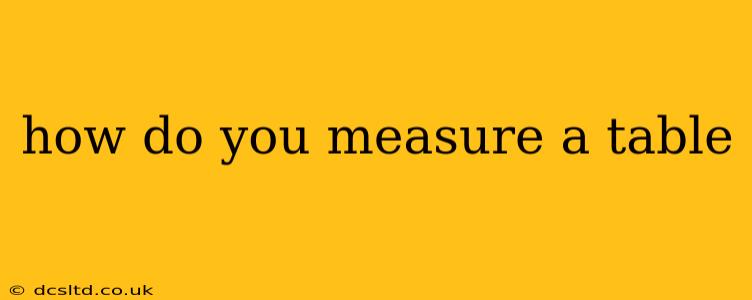Measuring a table might seem straightforward, but getting accurate dimensions is crucial for various reasons – from buying a table runner or tablecloth to ensuring it fits comfortably in a specific space. This guide will walk you through the process, addressing common questions and considerations.
What Measurements Do I Need?
The essential measurements for a table are its length, width, and height. However, depending on your purpose, you might need additional measurements like the diameter (for round tables), the depth of drawers or shelves (if applicable), and the thickness of the tabletop.
How to Measure Length and Width
- Choose your measuring tool: A tape measure is ideal, but a ruler can suffice for smaller tables. Ensure your measuring tool is accurate.
- Position the tape measure: Place the end of the tape measure at one end of the table's longest side (length) or shortest side (width). For rectangular or square tables, ensure the tape measure is parallel to the edge.
- Extend the tape measure: Extend it to the opposite end, keeping it taut and flat against the surface.
- Record the measurement: Note the measurement to the nearest inch or centimeter, depending on your preference. Repeat this process for the other dimension.
Tip: For tables with intricate designs or curved edges, take multiple measurements at different points and average them for a more accurate representation.
Measuring the Height of a Table
- Use a straight object: A level or a measuring stick is helpful to ensure accurate vertical measurement.
- Position at the table's edge: Place the measuring tool against the table leg at the edge where the tabletop begins.
- Measure to the tabletop: Measure vertically from the floor to the top of the tabletop. Record your measurement.
Measuring Round and Oval Tables
For round or oval tables, the primary measurement is the diameter.
- Find the widest point: Locate the widest point across the table.
- Measure across the diameter: Extend the tape measure from one side of the table's widest point to the other, passing through the center.
- Record the diameter: Note the measurement. For oval tables, measure both the longer and shorter diameters.
H2: What about the table's thickness?
The thickness of the tabletop refers to its depth from top to bottom. Measure this by placing the tape measure on the edge of the table and measuring vertically. This is crucial if you're buying a specific type of cover or trying to fit the table in a tight space.
H2: How do I measure a table with leaves?
Tables with leaves require measuring both the table's dimensions with and without the leaves extended. This information will be crucial if you plan to store it when not in use, or if you are looking for a tablecloth or cover that accommodates both configurations. Remember to measure the length and width with the leaves both in and out.
H2: Why is accurate measurement important?
Accurate measurements are crucial for several reasons:
- Buying a tablecloth or runner: Incorrect measurements can lead to a tablecloth that's too small or too big.
- Furniture placement: Ensuring a table fits in a specific space before buying it prevents space issues.
- Custom orders: Accurate measurements are essential for custom-made tabletops or table legs.
- Shipping and delivery: Accurate dimensions are necessary for calculating shipping costs and ensuring the table is transported safely.
By following these simple steps, you can accurately measure any table, regardless of its shape or size. Remember to take your time and double-check your measurements before making any purchases or decisions based on them.
